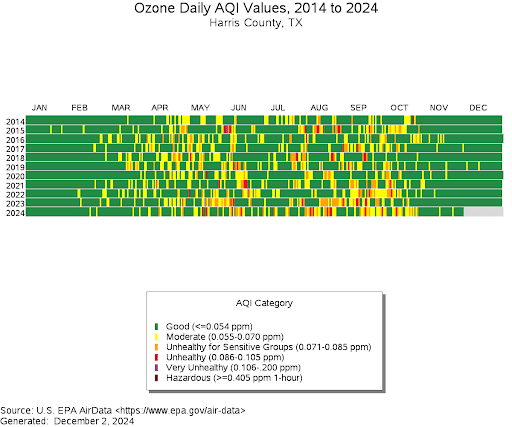
Dr. Inyang Uwak
Director of Research and Policy
Smog is also known as surface-level ozone (tropospheric ozone), which should not be confused with the ozone layer (stratospheric ozone) that protects us from the UV rays of the sun. Surface-level ozone is an air pollutant formed when the sun’s UV radiation interacts with nitrogen oxides and volatile organic compounds (VOCs). These two compounds are released into the atmosphere through human activity, such as burning fossil fuels.
Houston has an abundance of all these compounds, mainly from tailpipe emissions, industrial sources, and the climate. The National Ambient Standards are regulatory standards set by the US Environmental Protection Agency for criteria pollutants like ozone to protect public health.
Houston continues to be in non-attainment of those standards.
Who is most affected by ozone?
On hot sunny days, ozone can reach unhealthy levels and impact the health and well-being of sensitive populations. This includes children, older adults, outdoor workers, people with asthma, and other chronic respiratory diseases like bronchitis. Children are the most susceptible to harm from ozone exposure because their lungs are still developing, and they are more likely to be engaging in outdoor activities (Health Effects of Ozone Pollution | US EPA). Ozone, when inhaled, reacts with lung tissue and can cause various respiratory issues. It also reduces breathing capacity, which is particularly detrimental to those with respiratory disease. Exposure to ozone also increases one’s susceptibility to allergens (such as pollen), respiratory infections, and the effects of other air pollutants. Among asthmatics, exposure to ozone is associated with increased emergency room visits, hospital admissions, and deaths. Several pollutants react chemically to form ozone, mainly nitrogen oxides (NOx), combustion products, and volatile organic compounds (VOCs) such as ethylene and butadiene.
Ozone, chiefly a byproduct of human activity, is formed midair on warm, bright days when winds are light. Ozone forms most frequently near industrial areas in east Harris County, Texas City, and southern Brazoria County and may be transported in any direction. A study by Wang et al. 2023 found that most of the ozone production hotspots in Houston were located over the urban core of the city and industrial areas like the Houston Ship Channel, which is a network of chemical refineries, freeways, and homes. These locations had high nitrogen oxide (NOx) concentrations and volatile organic compounds (VOCs) generated from industry and vehicle emissions.
Data on Houston's smog problem
The US EPA’s Air Quality Index is one of the best available tools for determining ozone and particle pollution. AQI values above 100 indicate that air quality is unhealthy for certain sensitive groups of people, like those with asthma. As AQI values get higher above 150, they become harmful for everyone.
Air quality reaches unhealthy levels throughout the year but peaks between May and October. As illustrated in Figure 2, August and September have the highest ozone levels, possibly due to high Summer temperatures, reduced rainfall, and wind patterns. Further, data from the Texas Commission on Environmental Quality for the past five years show that ozone levels in the Houston area are worsening. In 2024, we had 55 high-ozone days in Houston, compared with 47 in 2023 and 30 in 2022.




Factors contributing to the ozone problem in Houston include but are not limited to high temperatures, emissions from the hundreds of chemical manufacturing facilities, emissions from oil refineries in East Harris County, wind patterns, and lack of rain.
How do we begin to better the Houston smog problem?
An effective plan to solve this complex air pollution problem includes additional regulations to control volatile organic compounds (VOC) and nitrogen oxide emissions from industry.
Regulatory agencies should place tighter restrictions on ozone precursor air pollutant emissions that contribute to the region’s health risks. Inspect and enforce to ensure full compliance with permitting regulations. Several EPA enforcement cases have demonstrated that many industrial plants lack adequate permits. Even when excess emissions are found, the industry often exploits legal loopholes and scientific uncertainty to avoid a citation and fine. Better investigation and enforcement would reduce air pollution and ensure that those companies that follow the law are not at a competitive disadvantage. Finally, on the part of industry, to reduce emissions from industrial processes, advanced technologies must be utilized to capture and reduce emissions.
Strategies to reduce transportation-related emissions contributing to ozone formation include promoting and improving public transportation use and accessibility. Cutting down on highway expansion projects and instead focusing on road maintenance and improvement, creating complete streets with safe bike lanes and pedestrian crossings. Further, encourage the use of innovative technologies that reduce traffic as well as implementing traffic reduction programs like lane narrowing and speed bumps, especially in residential areas. Promoting and incentivizing car-pooling and ride-share options is also key in the public sector.
Additional regulatory air monitoring is needed as many areas with extensive industrial facilities lack regulatory monitors to reveal just how much pollution there is. An example of one such area is South West Houston’s Fort Bend County, home to the WA Parish coal power plant, which is a significant contributor to soot pollution. Also, more air pollution research specific to the Houston region is needed to fill the gaps in understanding our complex pollution problem.
Endnotes
- Soleimanian, E., Wang, Y., Li, W., Liu, X., Griggs, T., Flynn, J., Walter, P. J., & Estes, M. J. (2023). Understanding ozone episodes during the TRACER-AQ campaign in Houston, Texas: The role of transport and ozone production sensitivity to precursors. Science of The Total Environment, 900, 165881. https://doi.org/10.1016/j.scitotenv.2023.165881
Read Part I from our predecessor, the Galveston-Houston Association for Smog Prevention (GHASP).

